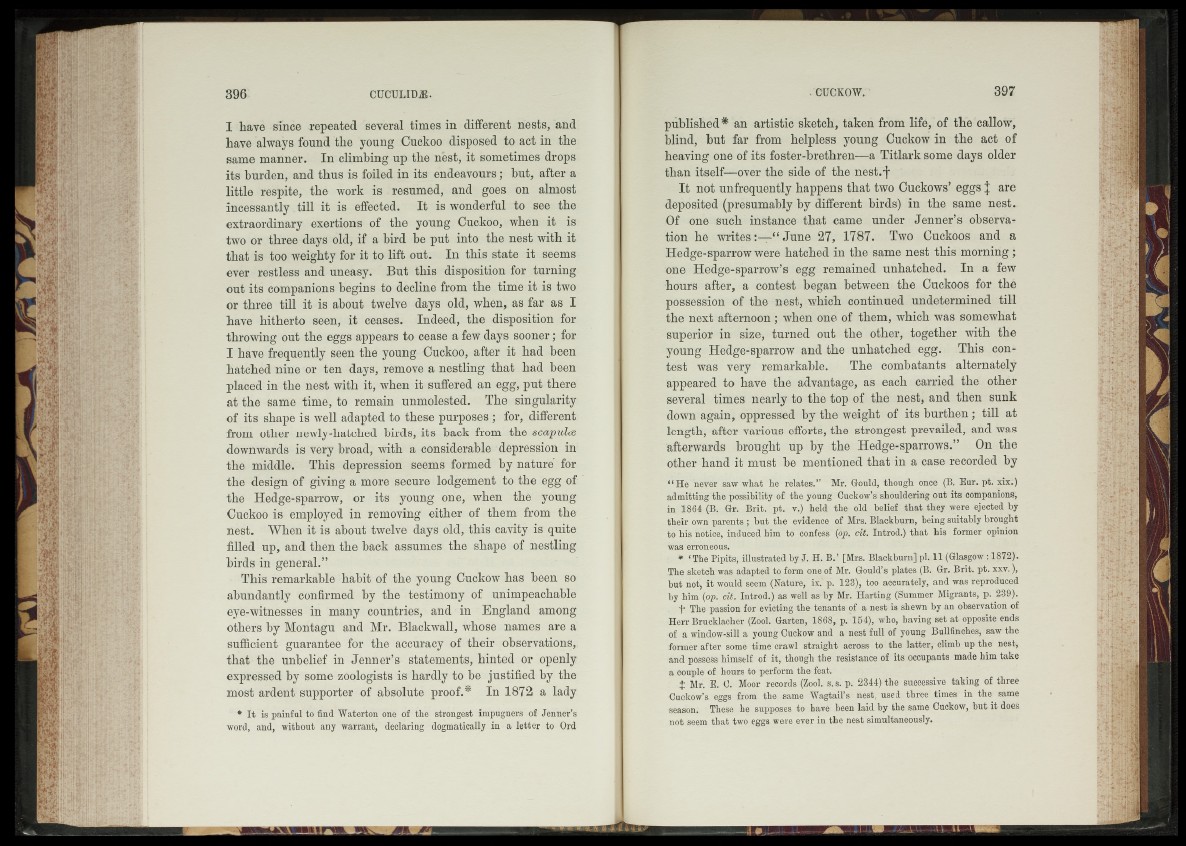
I have since repeated several times in different nests, and
have always found the young Cuckoo disposed to act in the
same manner. In climbing up the nest, it sometimes drops
its burden, and thus is foiled in its endeavours; hut, after a
little respite, the work is resumed, and goes on almost
incessantly till it is effected. It is wonderful to see the
extraordinary exertions of the young Cuckoo, when it is
two or three days old, if a bird he put into the nest with it
that is too weighty for it to lift out. In this state it seems
ever restless and uneasy. But this disposition for turning
out its companions begins to decline from the time it is two
or three till it is about twelve days old, when, as far as I
have hitherto seen, it ceases. Indeed, the disposition for
throwing out the eggs appears to cease a few days sooner; for
I have frequently seen the young Cuckoo, after it had been
hatched nine or ten days, remove a nestling that had been
placed in the nest with it, when it suffered an egg, put there
at the same time, to remain unmolested. The singularity
of its shape is well adapted to these purposes ; for, different
from other newly-hatched birds, its back from the scapula
downwards is very broad, with a considerable depression in
the middle. This depression seems formed by nature for
the design of giving a more secure lodgement to the egg of
the Hedge-sparrow, or its young one, when the young
Cuckoo is employed in removing either of them from the
nest. When it is about twelve days old, this cavity is quite
filled up, and then the back assumes the shape of nestling
birds in general.”
This remarkable habit of the young Cuckow has been so
abundantly confirmed by the testimony of unimpeachable
eye-witnesses in many countries, and in England among
others by Montagu and Mr. Blackwall, whose names are a
sufficient guarantee for the accuracy of their observations,
that the unbelief in Jenner’s statements, hinted or openly
expressed by some zoologists is hardly to be justified by the
most ardent supporter of absolute proof.* In 1872 a lady
* It is painful to find Waterton one of the strongest impugners of Jenner’s
word, and, without any warrant, declaring dogmatically in a letter to Ord
published* an artistic sketch, taken from life, of the callow,
blind, but far from helpless young Cuckow in the act of
heaving one of its foster-brethren—a Titlark some days older
than itself—over the side of the nest.f
It not unfrequently happens that two Cuckows’ eggs | are
deposited (presumably by different birds) in the same nest.
Of one such instance that came under Jenner’s observation
he writes :—<£ June 27, 1787. Two Cuckoos and a
Hedge-sparrow were hatched in the same nest this morning;
one Hedge-sparrow’s egg remained unhatched. In a few
hours after, a contest began between the Cuckoos for the
possession of the nest, which continued undetermined till
the next afternoon; when one of them, which was somewhat
superior in size, turned out the other, together with the
young Hedge-sparrow and the unhatched egg. This contest
was very remarkable. The combatants alternately
appeared to have the advantage, as each carried the other
several times nearly to the top of the nest, and then sunk
down again, oppressed by the weight of its burthen; till at
length, after various efforts, the strongest prevailed, and was
afterwards brought up by the Hedge-sparrows.” On the
other hand it must be mentioned that in a case recorded by
“ He never saw wliat lie relates.” Mr. Gould, though, once (B. Eur. pt. xix.)
admitting the possibility of the young Cuckow’s shouldering out its companions,
in 1864 (B. Gr. Brit. pt. v.) held the old belief that they were ejected by
their own parents ; hut the evidence of Mrs. Blackburn, being suitably brought
to his notice, induced him to confess (op. cit. Introd.) that his former opinion
was erroneous.
* ‘ The Pipits, illustrated by J. H. B.’ [Mrs. Blackburn] pi. 11 (Glasgow: 1872).
The sketch was adapted to form one of Mr. Gould’s plates (B. Gr. Brit. pt. xxv.),
but not, it would seem (Nature, ix.' p. 123), too accurately, and was reproduced
by him (op. cit. Introd.) as well as by Mr. Harting (Summer Migrants, p. 239).
+ The passion for evicting the tenants of a nest is shewn by an observation of
Herr Brucklacher (Zool. Garten, 1868, p. 154), who, having set at opposite ends
of a window-sill a young Cuckow and a nest full of young Bullfinches, saw the
former after some time crawl straight across to the latter, climb up the nest,
and possess himself of it, though the resistance of its occupants made him take
a couple of hours to perform the feat.
+ Mr. E. 0. Moor records (Zool. s.s. p. 2344) the successive taking of three
Cuckow’s eggs from the same Wagtail’s nest, used three times in the same
season. These he supposes to have been laid by the same Cuckow, but it does
not seem that two eggs were ever in the nest simultaneously.